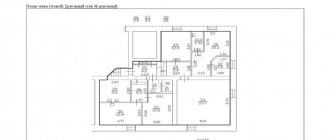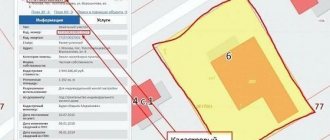Anyone who has ever carried out any actions with their real estate, be it the internal layout of a private house or one of the apartments in an apartment building, has been faced with the need to prepare or obtain such a document as a floor plan of the house. What kind of document is this? A floor plan is a graphic representation of all residential and non-residential premises that are located on one separate level of the house.
Layout of all floors of a two-story cottage
This document includes all apartments located at a given level, with load-bearing walls, openings (windows and doors), partitions, etc. marked on it. A floor plan can be drawn up for both residential and non-residential premises.
The floor plan is included in the folder of documents accompanying any real estate, and is a continuation of the cadastral passport and one of the parts of the technical passport.
When might a building floor plan be needed?
Firstly, you cannot do without a floor plan of a building or a project of a private house when registering privatization or ownership of a particular type of real estate.
Secondly, a floor plan is required when carrying out any transactions with real estate, be it the execution of a purchase and sale or exchange agreement, the registration of an inheritance, a deed of gift or a will for this real estate, i.e. for any notarized transactions.
In this case, the floor plan of the building or house will make it possible to clearly determine the shared ownership of each participant in the transaction, assigning him a specific share of the total area of the property.
Thirdly, a floor plan of a residential premises may be required when its intended purpose changes, for example, in the case when the area of residential real estate is planned to be used in the future for non-residential commercial premises. The floor plan clearly identifies all communications, window and door openings, partitions and structures, and therefore it will be easy to change the layout of the room to suit the new purpose.
How to find out which wall is load-bearing in a panel house
Panel houses are distinguished by the fact that they have special design codes, which can be used to understand how they were built. There are special databases in which, knowing the code, you can find a house plan and the required apartment, where it will be indicated which wall is load-bearing in it.
You can also find such a wall by measuring the thickness of surfaces. Non-load-bearing walls in panel houses usually have eighty millimeter or meter walls. And the underlying surface of interest has a thickness of one hundred and forty to two hundred millimeters.
If you decided to check the thickness of the wall before removing the finishing coating, then it can affect the obtained indicators; they take about fifty millimeters.
Demolition of a wall in a house made of panels is guaranteed to lead to the collapse of the structure.
You can find such a wall by measuring the thickness of the surfaces.
How and where to get a floor plan of a building (house)
If you need to get a floor plan of a building or house, you need to follow clear instructions, and then no bureaucratic machines are afraid of you.
But before you begin the process of obtaining a floor plan, make sure that you have enough funds to pay the state fee (the amount of the state fee will be reported to you by the BTI, and it will depend on the area of the premises), and that your real estate documents are in order (a warrant for an apartment, owner's certificate, etc.).
If everything is in order, then proceed to obtain the floor plan. So where to start?
First, you need to determine the coordinates and contacts of the organization that issues the floor plan in your city.
This is in charge of the Bureau of Technical Inventory (the familiar BTI). But where you live, it may be called “Rostekhinventarizatsiya”.
Secondly, by calling the phone number listed in the BTI directory, sign up to receive a technical passport. The BTI does not always make a preliminary appointment, so be prepared for the fact that you will have to sit in a live queue for some time before you get to the inspector you need.
How to find out where the load-bearing wall is in an apartment
Determining the location of the wall responsible for the reliability of the structure is allowed in a number of ways. The first option is to look at the floor plan, it is requested from the capital construction department.
Every homeowner has a technical passport of their home, but if a person does not have knowledge of construction issues, then it will be difficult for him to understand the drawings, and this document is unlikely to help him.
More convenient and easier, to a certain extent, methods are recognizing the load-bearing surface by the thickness and location of the walls. To distinguish a load-bearing surface from a non-load-bearing one, you first need to get rid of all surface finishing, right down to removing the plaster layer. Having eliminated excess layers from the surface, proceed to measuring its thickness. But each material has different width indicators:
- brick walls have a minimum thickness of three hundred and eighty millimeters when it comes to the load-bearing side;
- a house made of panels is distinguished by the presence of many foundation walls, having a thickness of one hundred and forty millimeters. It should be noted right away that changing the walls of such a house is permissible only in rare cases;
- monolithic buildings have a load-bearing structure index of twenty centimeters.
This method is quite complicated, for this reason you can request data from the person responsible for building a house floor plan, which will simplify the task.
To distinguish a load-bearing surface from a non-load-bearing one, you first need to get rid of all surface finishing, right down to removing the plaster layer.
According to their location, such walls are built in certain parts:
- all surfaces that are external are responsible for the strength of the house, and of course, are considered load-bearing;
- overlapping surfaces between 2 adjacent rooms also belong to this category of walls;
- all surfaces facing the landing belong to the foundation walls.
All surfaces that are external are responsible for the strength of the house, and of course, are considered load-bearing.
Having determined that the wall where you plan to make changes is load-bearing, you need to understand whether the planned actions are permissible. Such structures cannot be demolished; usually, niches and openings can be created in them.
But here it is also forbidden to do anything, the number of changes is limited and there are subtleties in creating them. It is not recommended to carry out such repair work on your own; you should contact a specialist. Without this, they may simply refuse to remodel the room. Which will lead to danger to life, because then no one will give a guarantee that the work was carried out correctly. Also, the sale of such an apartment will become impossible.
If the project involves demolition of part of the surface, then it is absolutely impossible to do without a professional. At the same time, he must have the appropriate permits; all other activities will be illegal.
A specialist will be able to properly strengthen the surface so that it stands firmly and does not collapse in the future.
Such structures cannot be demolished; usually, niches and openings can be created in them.
Why is explication needed?
Explication, like the floor plan of a house (building), is an important component of the technical passport of real estate.
- Based on the explication, it becomes possible to plan future renovations, calculating the amount of necessary materials, design the arrangement of furniture in the rooms, think through the elements of room redevelopment, and much more.
- The data included in the explication are the starting figures that form the basis for calculating utility bills for your apartment. Sometimes ordering an updated explanation and submitting it to the housing management company allows you to recalculate the amount of utility bills and save significantly on this.
- It is the explication that is the basis for registration in order to improve your living conditions. This is possible if the size of the area of your apartment (common or residential) differs significantly from the norm in a smaller direction.
As you can see, an updated explanation is just as important as a floor plan, so don’t be lazy about updating it for your property.
The procedure for obtaining an explication is similar to that described above for obtaining a floor plan. The production time for an updated explanation is on average from ten to fourteen days, depending on the workload of the BTI. And finally, I would like to give one piece of advice. If you want to speed up the process of obtaining a floor plan and explication of your property, express your desire to the BTI. Most often, they have such a service as urgent processing of documents, but be prepared for the fact that this will cost you a little more than the usual procedure.
What is a load-bearing wall
Load-bearing walls include those surfaces onto which the weight of the higher part of the structure is transferred; these include floor slabs, other walls, and beams. In some buildings, the load-bearing elements are not walls, but columns and beams.
Therefore, if it was decided to redevelop the building, it is so important to accurately determine the location of the load-bearing surface. After all, the safety of the residents of the apartment, as well as all the residents of this house, will be in great question. Thus, making changes without approval from the authorities is fraught with serious consequences. In addition to the long running around to legitimize the finished redevelopment, one should not forget about the possibility of making changes that could lead to destructive actions in relation to the building.
The owner of the apartment cannot know what changes were made by the owners of other apartments; only the BTI authorities know this, where all the changes are indicated, and they can say for sure whether it is possible to make any other changes to each specific load-bearing wall or not.
Load-bearing walls include those surfaces onto which the weight of the higher part of the structure is transferred.
For this reason, any replanning begins with the following steps:
- inviting BTI workers to the apartment so that they indicate the design of which walls can be changed;
- It is better to legitimize changes in the layout of the premises in advance, then it will require less time and effort;
- Also, to make it easier to plan the repair yourself, you can independently determine the location of the load-bearing surfaces. Accordingly, the project can be prepared in advance, and official representatives will only document and confirm the possibility of carrying out the work.
It is better to legitimize changes in the layout of the premises in advance, then it will require less time and effort.
Requirements for load-bearing structures:
- they are necessarily distinguished by their strength and reliability, because they are responsible for the durability of a large number of building elements;
- fire safety refers to their properties;
- meet other safety requirements;
- In addition to pressure from above, there is pressure on them and on the sides; all these factors are taken into account when restructuring the surface in a living room.
Load-bearing walls are elements of a building that are subject to strong pressure, so their thickness is greater than that of other types of walls, which are responsible only for their own weight. This indicator differs from the type of house, materials used during construction work, it is determined by standards, so this factor makes it easier to determine which wall is load-bearing.
Standards, including those prescribed in SNIP. And it is according to them that organizations carrying out construction are guided; if they are not observed, the building will not be allowed to be delivered, and the relevant documents will not be drawn up.
In many cases, it is better to do without affecting this surface, and create a project according to which changes will be made on non-load-bearing walls.
But each type of house has its own characteristics.
Load-bearing walls are elements of a building that are subject to strong pressure, so their thickness is greater than that of other types of walls.
How to find out which wall is load-bearing in a brick house
It is worth finding such a surface in a house built of bricks in terms of thickness, given that between them there are layers of special mortar that secures them. The total thickness thus depends on the number of bricks stacked. And it can range from 120 centimeters to 380, although it can be thicker.
In this matter, only surfaces thicker than 380 centimeters are considered load-bearing; anything thinner does not apply to them.
It is more difficult to find a brick house in the database using the code, so you should not waste time on this; perhaps there is no house in the database at all.
In this matter, only surfaces thicker than 380 centimeters are considered load-bearing.
How to find out which wall is load-bearing in a Khrushchev building
Khrushchev buildings have the same construction plan, so determining the required wall is easy. You just need to know that in such houses, load-bearing structures include all external walls, and inter-apartment surfaces, as well as surfaces facing the landing.
But, to be sure, you can also focus on the thickness; all surfaces on the inside that are thicker than one hundred and twenty millimeters are load-bearing surfaces.
Which walls can be demolished in a Khrushchev building, the answer is those that are thinner than this indicator can be eliminated. But it is not advisable to touch the dividing wall between the balcony and the room. After all, it was erected so that excess cold did not enter the room. Such a project will not receive permission from the authorities responsible for this issue.
Another way to note is the use of surface drilling; ordinary walls can be easily drilled, but load-bearing walls will be broken by drills.
Khrushchev buildings have the same construction plan, so determining the required wall is easy.
How to distinguish a load-bearing wall from a non-load-bearing one
So, there are several methods that can be applied in certain cases, these include:
- Studying the documentation received from the BTI is not an easy process, given the fact that you need to have knowledge in this area, otherwise you can easily make a mistake. And in such a matter, a mistake can be fatal. It is better to turn to professionals;
- The tapping method has not been described previously; it involves determining the type of surface, focusing on the sound it produces when tapping on it. Of course, such a technique hardly meets the reliability parameter. After all, some walls, even not being load-bearing, can emit a sound similar to them;
- determining a wall by its thickness. We should not forget that finishing also makes adjustments to the thickness of the surface; the correct measurement will be the surface cleared of finishing materials. For each type of structure, which differs in the materials from which they are built, there are specific standards for the thickness of such surfaces. They are described above;
- drilling a wall to understand how thick the surface is, or even the material and its reaction, a drill can tell what type the surface is.
Of course, particular moments can also make adjustments to the correctness of the surface definition.
Drilling into a wall to understand how thick the surface is, or even the material.
How to find out which wall is load-bearing in a monolithic house
These premises are distinguished by their various structural options in architectural solutions. They may have load-bearing walls, as well as columns and beams.
If the wall surface is thicker than two hundred millimeters, this means that it is load-bearing. Columns are often much thicker than walls, but the main thing to understand is that any structure thicker than two hundred millimeters is considered a load-bearing structure.
In new monolithic houses, it is even easier to recognize such walls. To do this, you just need to look at them; all these surfaces in these houses are built from reinforced concrete. In addition, you can see the armholes treated with the solution.
In new monolithic houses, these surfaces are constructed from reinforced concrete.










